
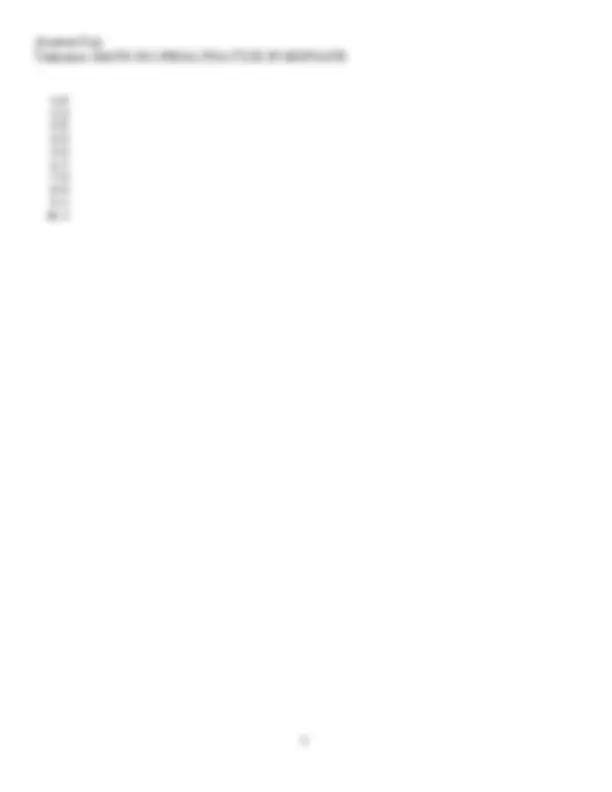
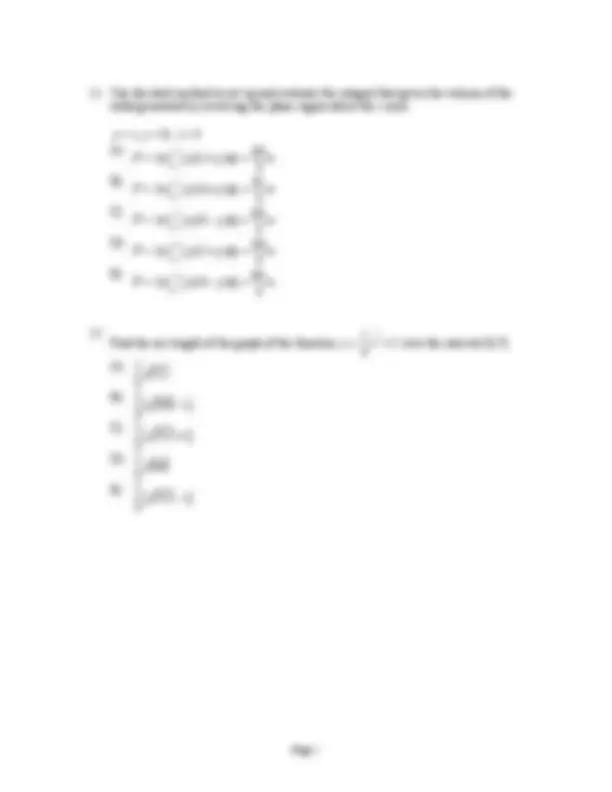
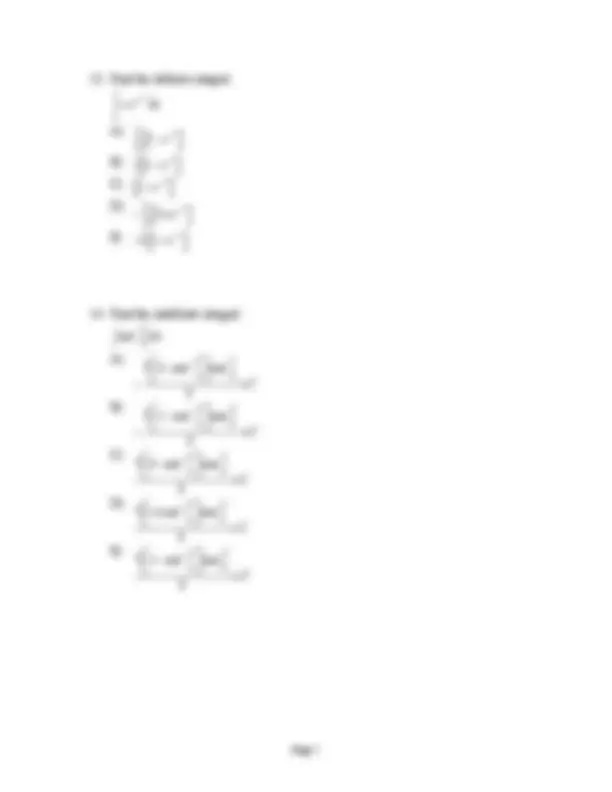
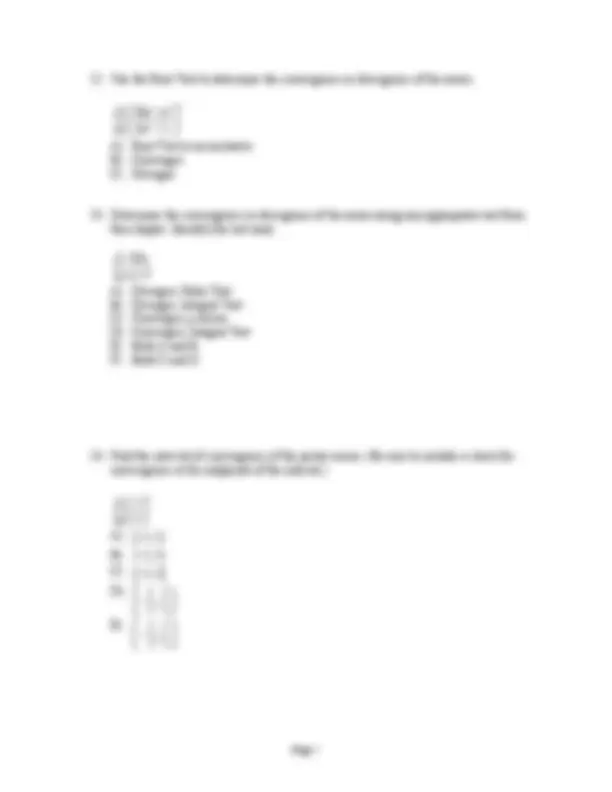
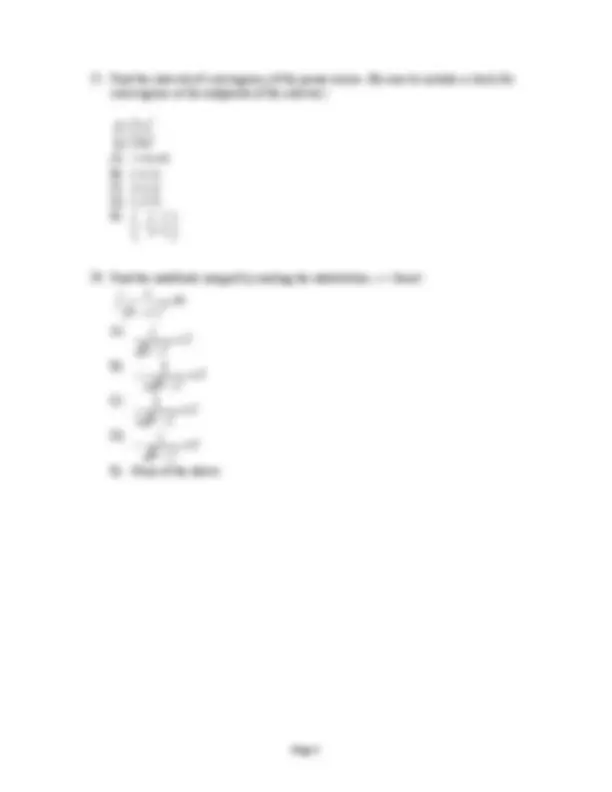
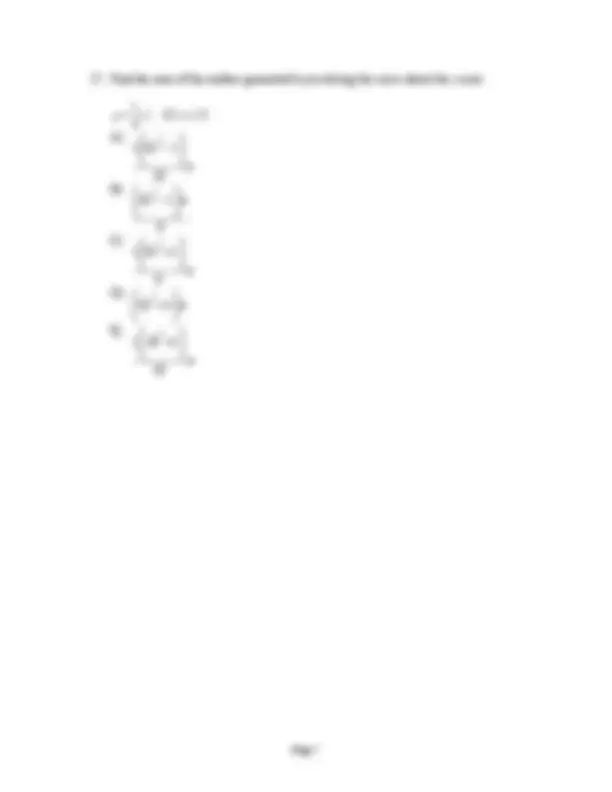


Study with the several resources on Docsity

Earn points by helping other students or get them with a premium plan


Prepare for your exams
Study with the several resources on Docsity

Earn points to download
Earn points by helping other students or get them with a premium plan
Community
Ask the community for help and clear up your study doubts
Discover the best universities in your country according to Docsity users
Free resources
Download our free guides on studying techniques, anxiety management strategies, and thesis advice from Docsity tutors
A set of practice problems for the final exam of a calculus ii course, covering topics such as curve length, area of shaded regions, volume of solids, work, integrals, sequences, and series. It includes multiple-choice questions, recursion formulas, and problems to solve.
Typology: Exams
1 / 11

This page cannot be seen from the preview
Don't miss anything!







Math 2012 Calculus II Final Practice Spring 2008
Name: Last ___________________, First ______________________
MULTIPLE CHOICE. Choose the one alternative that best completes the statement or answers the question.
Find the length of the curve.
y = (16 - x2/3) 3/2^ from x = 1 to x = 64 A) 96 B) 90 C) 180 D) 60
Find the area of the shaded region.
2 4 6 8 10 x
y 8 6 4 2
2 4 6 8 10 x
y 8 6 4 2
y = 2x y = x - 4
A) 32 B) 32 3 C) 128 3 D) 64 3
Find the volume of the solid generated by revolving the shaded region about the given axis.
π^ x 2
y 4
2
π^ x 2
y 4
2
y = 3 sin x
A) 9 2 π2^ - 3π B) 9 2 π2^ - 9π C) 9 2 π2^ D) 9 2 π2^ + 9π
Solve the problem.
A rescue cable attached to a helicopter weighs 2 lb/ft. A 160 - lb man grabs the end of the rope and is pulled from the ocean into the helicopter. How much work is done in lifting the man if the helicopter is 50 ft above the water? A) 13,000 ft (^) · lb B) 2660 ft (^) · lb C) 8100 ft (^) · lb D) 10,500 ft (^) · lb
1
Integrate the function.
A) 4 x 16 - x^
C B) x 16 16 - x^
(^16) x^ - x2+ C
C) x 4 16 + x^
C D) x 16 16 + x^
C
Express the integrand as a sum of partial fractions and evaluate the integral.
A) 4 3 ln x8(x (^) + 6)2^ + C B) 1 6 ln x8(x (^) + 6)2^ + C
C) 1 6 ln x
8 (x (^) + 6)^
C^ D)^ ln^ x^8 (x (^) + 6)^
C
Evaluate the integral.
π/
0
A) 1 5 x3 sin 5x - 3 25 x2 cos 5x + 6 125 x sin 5x + 6 625 cos 5x + C
B) 1 5 x3 sin 5x (^) + 3 5 x2 cos 5x (^) - 6 5 x sin 5x (^) - 6 5 cos 5x (^) + C
C) 1 5 x3 cos 5x + 3 25 x2 sin 5x - 6 125 x cos 5x - 6 625 sin 5x + C
D) 1 5 x3 sin 5x (^) + 3 25 x2 cos 5x (^) - 6 125 x sin 5x (^) - 6 625 cos 5x (^) + C
A recursion formula and the initial term(s) of a sequence are given. Write out the first five terms of the sequence.
a 1 = 1, a 2 = 3 , an+ 2 = an+ 1 - an A) 1, - 3 , 4 , - 5 , 6 B) 1, 3 , 2 , 1 , 0 C) 1, - 1, 2, - 3, 5 D) 1, 3 , 2 , - 1, - 3
Determine if the series converges or diverges; if the series converges, find its sum.
∞
n= 1
4n+^1
A) Converges; 100 B) Converges; 20 C) Converges; 80 D) Diverges
Find the Taylor polynomial of order 3 generated by f at a.
f(x) = x^3 , a = 7 A) 343 + 49(x - 49) + 49(x - 49)^2 + (x - 49)^3 B) 6 + 3(x - 49) + (x - 49)^2 + (x - 49)^3 C) 343 + 147(x - 49) + 21(x - 49)^2 + (x - 49)^3 D) 1372 + 147(x - 49) + 14(x - 49)^2 + (x - 49)^3
2
y = x , y = 0, x= 4 A) 2 0
0
0
0
0
Find the arc length of the graph of the function
3 (^2 ) 3
y = x + over the interval [0,7].
A) 2 512 3 B)
0
x e −^ x dx ∫
A) (^1) – 1 2
(^) −e
B) (^) 2 1 (^) −e–4 C) (^) 1 −e–4 D) (^1) – 1 2
− ^ +e
E) (^) –2 1 (^) −e–4
sin^3 7
x ∫ dx A) (^2) 7 3 cos cos 7 7 3
x x
C
7 2 cos cos 7 7 3
x x
C
7 3 cos cos 7 7 3
x x
C
7 1 cos cos 7 7 3
x x
C
7 2 cos cos 7 7 3
x x
C
0
n^9 n
∞
=
∑
A) Diverges B) Converges C) Cannot be determined from the methods in the chapter
5 (^1 )
n (^) n
∞
=
∑
A) Inconclusive B) Converges C) Diverges
0
n
n
∞
=
∑
A) Inconclusive B) Converges C) Diverges
5
1 6
n n
∞ n
=
∑
A) Diverges B) Converges C) Ratio Test is inconclusive
2 2 1
n
n
n n
∞
=
∑
A) Root Test is inconclusive B) Converges C) Diverges
1
n^5
n n
∞
= +
∑
A) Diverges; Ratio Test B) Diverges; Integral Test C) Converges; p-series D) Converges; Integral Test E) Both A and B F) Both C and D
n
n
∞ x
=
∑
A) (^) [ −2, 2) B) ( 2, 2)− C) (^) [ −2, 2] D) (^1 ) , 2 2
(^1 3) , 0 3 3
y = x ≤ x≤
A) 3 1 82 2 1
18
π
π
π
π
Answer Key 2 nd 10